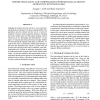Free Online Productivity Tools
i2Speak
i2Symbol
i2OCR
iTex2Img
iWeb2Print
iWeb2Shot
i2Type
iPdf2Split
iPdf2Merge
i2Bopomofo
i2Arabic
i2Style
i2Image
i2PDF
iLatex2Rtf
Sci2ools
ICIP
1994
IEEE
1994
IEEE
Theory, Simulation and Compensation of Physiological Motion Artifacts in Functional MRI
Mapping the location of brain activity is a new and exciting application of magnetic resonance imaging (MRI). This application area has already seen the use of a variety of magnetic resonance image acquisition methods, including spin-warp, spiral k-space, and echo-planar imaging, each of which has its own advantages and disadvantages. In this paper, we examine physiological sources of image artifacts for functional brain mapping with MRI. In particular, we examine the nature of respiration-related signal changes in the brain and characterize the response of spin-warp and spiral k-space imaging to this source of artifacts. This characterization uses a model in which the respiration causes an undesired periodic structure in the Fourier domain of the image. We present simulation and experimental results to support this model and also present several methods to compensate for these effects so that these imaging methods can be used to generate artifact-free images.
ICIP 1994 | Image Processing | Magnetic Resonance Image | Magnetic Resonance Imaging | Spiral K-space |
| Added | 29 Oct 2009 |
| Updated | 29 Oct 2009 |
| Type | Conference |
| Year | 1994 |
| Where | ICIP |
| Authors | Douglas C. Noll, Walter Schneider |
Comments (0)

